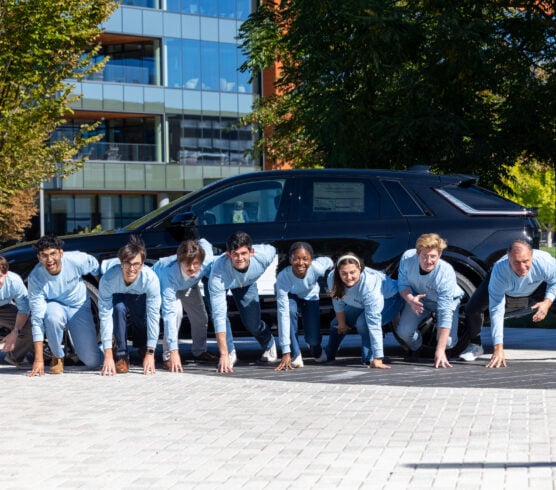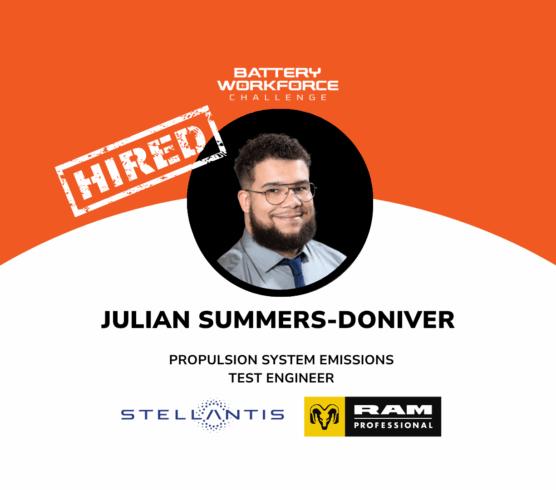
THE BUILD YEAR
Year 2 of EcoCAR, lovingly dubbed as “the build year”, is always a pivotal moment for teams – this is the year that teams execute their Year 1 design plans on a physical vehicle. The challenge directs the teams to remove the stock LYRIQ electric drive unit, and replace it with team-selected sponsored drive units that were chosen through a rigorous simulation process in Year 1. As organizers and students delved into Year 2 together, it became clear that EVC Year 2 would be a great learning experience for all those involved.

Tackling Hardware Integration
Integrating unique powertrains into the LYRIQ was no small feat. Unlike previous series where students added electric powertrains to conventional vehicles, this year required teams to replace the existing system with either AWD or RWD setups. Initially perceived as simpler, this task proved more complex than anticipated.
Packaging issues are a major hurdle for EVs. Modern EVs use the battery as a structural component, which heavily restricts modification space for EcoCAR teams. The complex EV cooling system posed even greater challenges. Battery temperature maintenance is critical for safety and rigorously tested by OEMs, making the cooling system sensitive to modifications. Moving critical components was initially deemed unsafe.
After finalizing the motor sponsor set, GM and sponsors like AAM collaborated, sharing Computer Aided Design (CAD) files to assess the feasibility of integrating third-party units into the LYRIQ. They determined the battery cooling system needed modification, prompting GM to develop, manufacture, and calibrate a custom cooling system for EcoCAR.
“This unprecedented effort required custom tooling from a GM supplier. With custom parts distributed and software implemented, all 13 teams successfully integrated their chosen motors, both AWD and RWD, into their vehicles,” said EcoCAR Sr. Program Manager, Jesse Alley.

Overcoming Cybersecurity Hurdles
Replacing the stock electric drive unit posed significant challenges. Stock EV drive units are integrated packages, and removing the LYRIQ’s unit meant losing the stock control module, disrupting the CAN network. Students had to recreate missing CAN signals and populate the network using Speedgoat control units.
Cybersecurity added another layer of difficulty. Modern vehicles have stringent protections against outside access, requiring students to replicate encrypted CAN messages to maintain network integrity.
“This was a first for EcoCAR, requiring students create controls software for their motors and encrypt messages to ensure seamless vehicle operation,” said Propulsion Controls & Modeling Engineer, David Ord. “All systems had to be perfectly functional for the vehicle to power on.”
Collaboration between EcoCAR sponsors, including GM and MathWorks, was crucial. They developed an EcoCAR-specific software toolbox to simplify cybersecurity implementation, sharing proprietary algorithms for message encryption. While the toolbox handled core encryption functions, students had to implement and test each message.
GM engineers also provided blueprints for recreating core algorithms lost with the stock control module, such as vehicle speed, range control, and torque control.

Triumphs and Collaboration
Despite the complexities, the dedication of EcoCAR sponsors and the hard work of the students led to significant achievements. Two vehicles successfully drove under their own power at GM’s Desert Proving Ground in Yuma, proving that these unique challenges could be overcome.
Collaboration among teams also played a crucial role. Sharing software algorithms, tools, and even hard-to-source hardware, teams supported each other throughout the year. This spirit of cooperation exemplifies the core tenet of EcoCAR: success through collaboration.

Looking Ahead
Year 2 of the EV Challenge has been the most technically challenging yet. Students faced unprecedented responsibilities in creating their desired EV powertrain architectures. Through persistence, ingenuity, and unwavering sponsor support, EcoCAR continues to offer a unique experience where future engineers transform challenges into triumphs. The lessons learned this year will undoubtedly pave the way for Year 3 and even greater innovations in the future.
Written by: Riddhi Puranik



